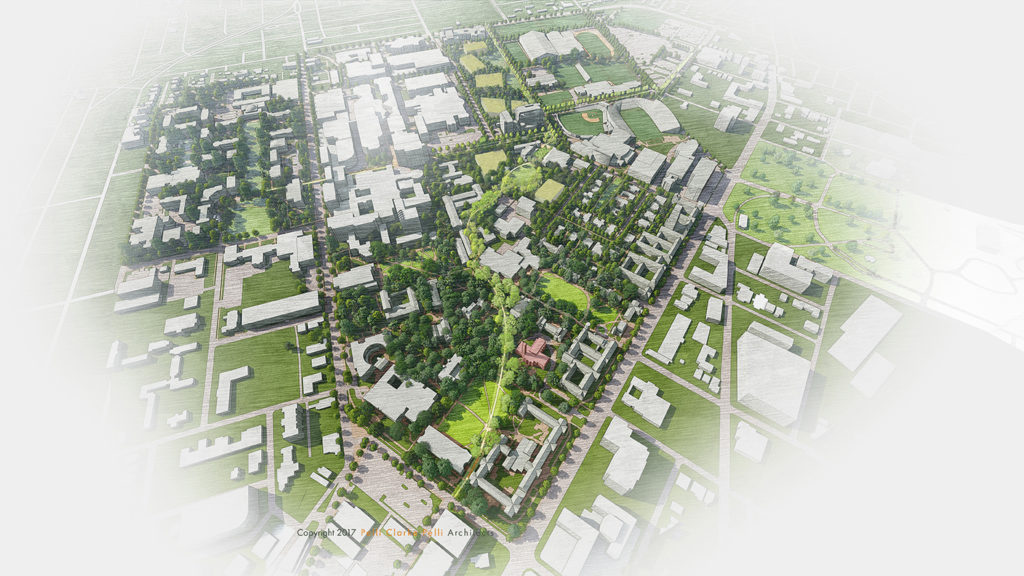FutureVU Land Use Plan Framework
The Vision for the Future

The FutureVU Land Use Plan represents a high level, holistic vision for physical development of the campus for the next 20 to 30 years. The vision includes long term campus-scale and neighborhood-scale transformative projects, endeavoring to establish legible connections within the campus and extending to surrounding communities. The plan identifies existing open spaces and creates new open spaces through suggested future building placement, driven by the Academic Strategic Plan and mission of the university, and purposeful integrated landscape projects. Existing campus neighborhood characteristics are defined and enhanced, and emphasis is placed on the physical humanistic experience of the campus. The diverse hues of each neighborhood will be celebrated and united into an integrated palette through the following objectives:
Clarify
- FutureVU aspires to strengthen the beauty and diversity of the campus by clarifying and building on the unique characteristics of each campus neighborhood.
Interact
- Protect and strengthen existing open spaces and create new open spaces as vibrant places of intellectual and social interaction.
Connect
- Connect the campus edges and spaces with a legible and logical Greenway, providing strong and appropriate paths of circulation for pedestrians, bicycles and vehicles.
Views
- Open visual connections into and within the campus to enhance the clarity of new and existing spaces.
Mitigate
- Mitigate those factors that contribute adversely to the campus experience.
Support
- Create support systems to safeguard and conserve the campus physical resources and allow it to flourish, grow and sustain itself into the future.
Campus as a Series of Neighborhoods
Vanderbilt’s master planning history reveals that campus grew as parcels of land were acquired, creating the development of distinct clusters or neighborhoods that are often different in architectural style, landscape and character. These distinct campus neighborhoods are referenced throughout the FutureVU Land Use Plan documents. The neighborhoods include:
- Historic Core Neighborhood (Historic Core)
- West End Neighborhood (West End)
- Central Neighborhood (Central)
- Highland Neighborhood (Highland)
- Peabody Neighborhood (Peabody)
- Student Village Neighborhood
- Triangle Neighborhood (Triangle)
- Athletics Neighborhood (Athletics)
Each neighborhood is described in more detail here.
Transformative Projects
Opportunities to meet the objectives of the FutureVU land use vision are defined through a series of transformative projects. These projects have been developed to address specific opportunities and challenges that exist within the various campus neighborhoods. Neighborhood specific opportunities are built on the foundation of the notion of a campus Greenway. The Greenway, a connective network of paths and open spaces, will define primary pedestrian circulation routes and collect the main public campus spaces along the way. The Greenway will result in the creation of new campus gathering spaces and amenities, and will be an accessible and unifying thread within the campus fabric.
Transformative projects focus on the following primary elements in order to bring all campus neighborhoods into balance:
- Greenway
- Open/Gathering Spaces
- Gateways and Edges
- Street Networks and Access
- Bikes and Pedestrians
- Parking Strategies
- Building Opportunities
- Sustainability – Site and Landscape
- Sustainability – Stormwater
The FutureVU Land Use Plan presents a conceptual framework for future development and articulates possibilities for future building placement, among other enhancements to the built environment. It does not, however, represent actual design. The implementation of FutureVU will be a dynamic and evolving process. As the university moves into implementation, designs will be refined and enhanced through continued planning efforts and studies (i.e. BlueSky Energy Vision, Accessibility Master Plan, MoveVU, etc.); however, the guiding principles will be the element of consistency for all endeavors.
Campus-Wide Project
- The Greenway Network
Neighborhood Specific Projects
- Historic Core
- West End
- Central
- Highland
- Peabody
- Student Village
- Triangle
- Athletics
Learn More
The Executive Summary is a full color 73-page report that summarizes the FutureVU land use planning process, provides a brief overview of the information gathering phase and campus analysis, and emphasizes the guiding principles. The document also includes the FutureVU land use framework and details on each of the transformative projects. It is a summary of the FutureVU Land Use Plan and expands on the material provided on this website. You can read the executive summary here.

